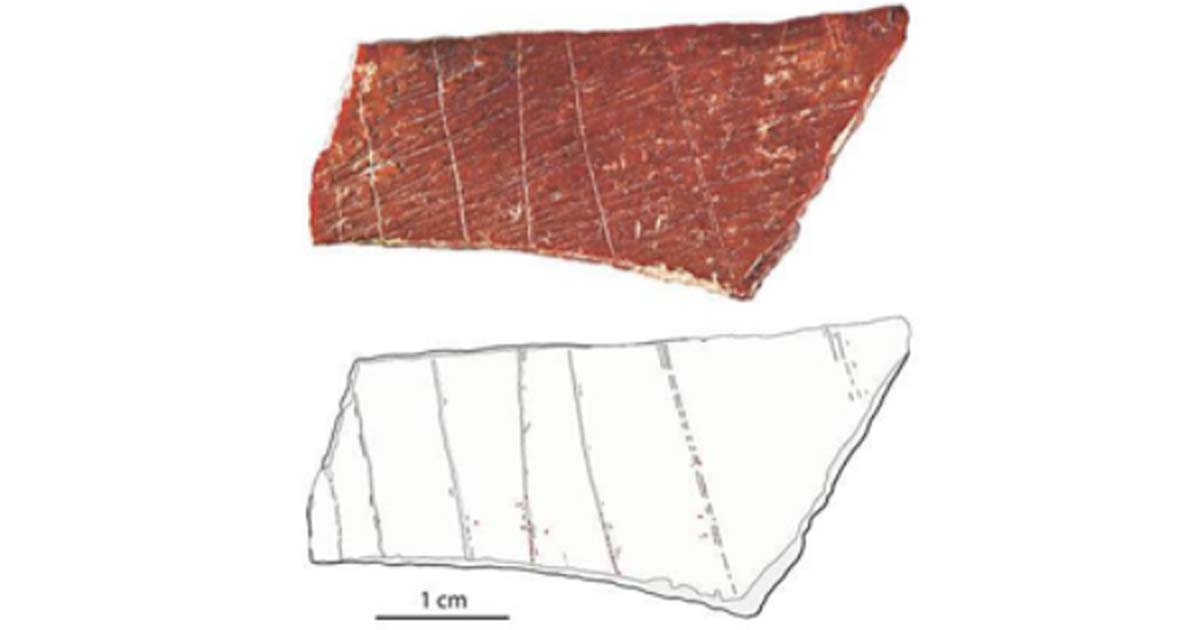Oldest Human Bone Engraved and Painted By Hominid Found In China
In China a team of archaeologists has made a significant discovery after examining a human bone that may be up to 125,000 years old. They found a small bone that shows signs that it was cut and then painted with ochre. This is the oldest known example of this practice from prehistory. It also indicates that extinct humans who once lived in East Asia were much more sophisticated than is often assumed.
The bones were found in Xuchang, in the central Chinese province of Henan. They were unearthed at a site called Lingjing by an international team, who has been digging at the location since 2005. It was once inhabited by an extinct species of archaic hominids.
According to the Indian Express, the archaeologists have unearthed “45 fragments of human cranial fossils at the site which has since been pieced together and named the ‘Xuchang Man’”. They were found in a layer that was dated to 105,000 to 125,000 years ago. These bones were then analyzed by the team, whose members come from China, France, and Norway.
Incised Human Bone
Researchers found that two of the bones, from the ribs, were engraved. These specimens would have been too brittle to have had any practical use and the incisions were such, that it is highly unlikely that they were created by chance. The bones were then studied under a microscope and it was found that they had a series of consecutive markings, made using tools.

These fossilized bones showing evidence of cut marks made by early humans, but not deliberate engravings. (Judgefloro / Public Domain)
To the amazement of the team, their analysis found the residue of ochre, an earthy pigment, in the carved lines of one bone. It had been engraved with seven lines and ochre had been painted onto the specimen. Antiquity reports that this “research provides the first evidence for the deliberate use of ochred engravings”.
It seems that the piece of human bone was intentionally colored and turned into a piece of art or some other cultural artifact. There have been many instances of prehistoric people inscribing human bones. At the Cheddar Gorge site in England, evidence was found that early humans ate their family members and etched on their bones, possibly as part of some ritual.

This original fragment of a rib bone contains the oldest known carving of its type in Britain. (Victuallers / CC BY-SA 2.0)
Could Archaic Humans Have Thought Like Us?
The bones found in central China seems to suggest that early humans had cultural beliefs. The carved lines and the use of pigment were intended to represent some idea or cultural concept.
The Indian Express quotes Luc Doyon, one the co-authors of the study, that “this discovery indicates that the production of abstract motifs, possibly used for symbolic purposes, was an integral part of the cultures” of the extinct humans who once populated the area. This would seem to indicate that they may have had similar mental processes to modern humans.
- Engraved Crimean Stone Artifact May Demonstrate Neanderthal Symbolism
- Skull Cups and Chewed Bones: Cannibalism was Ritual Behavior during Stone Age say Researchers
- ‘Abundant’ Occurrence of Skeletal Abnormalities Found in Early Humans

Extinct species of archaic hominids from 130,000 years ago. (Gerbil / CC BY-SA 3.0)
It appears that at some period in time in prehistory, the people who lived in this area stopped seeing bones as by-products of the slaughtering of animals and saw them as suitable for symbolical or artistic expression. Doyon stated that at some point in time they “considered this raw material as a good medium to permanently record abstract patterns” according to the Indian Express. This would show that the archaic humans who lived there, were adaptable and capable of change.
The people who inhabited Lingjing in the Pleistocene were clearly sophisticated. The international team found stones and antlers used to sharpen and make tools. These are among the earliest stone tools, ever found in East Asia.
The Mystery of the Bone’s Meaning
The discovery of ochred bones and other finds at Lingjing are changing experts’ views on the population who lived in the area, in Pleistocene times. They had a complex culture and may even have had mental capabilities comparable to Homo sapiens. However, the exact meaning of the engraved and painted bone is still a mystery. If we could decipher what it meant we could have a greater insight into the minds of early humans. The team’s findings are published in full in the peer-reviewed journal Antiquity.
Top image: Photograph (top) and tracing (bottom) of an engraved human bone fragment found at Lingjing in China’s Henan Province. Source: Francesco d’Errico and Luc Doyon / Fair Use.
By Ed Whelan



















